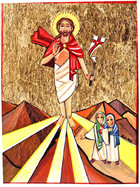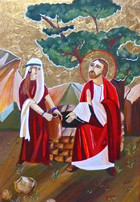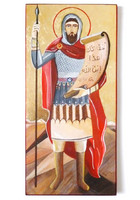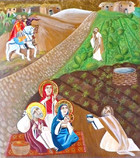Rania Kuhn
Christianity followed a different path in Egypt after a 5th century theological dispute with the Byzantine Orthodox Church, developing its own sacred art forms. One of the most interesting contemporary Coptic Orthodox icon-makers happens to live in France. Raised as a Coptic Christian in Cairo, Rania Kuhn was interested in arts and crafts from an early age and received a degree in Art Education from Helwan University in the Egyptian capital in 2000. A fellow student invited her to come to the icon workshop of the city’s Coptic Institute. As Kuhn recalls: “I knew immediately this was what I wanted to do. Every return visit only deepened my desire to be an iconographer.”
In Kuhn’s Cairo student days, she donated icons to Coptic communities that could not afford them. It has been years since Kuhn visited her homeland, and she has now added European saints like Brigid of Kildare, Martin of Tours, and Elisabeth of Hungary to her iconographic roster, but she still honors her Coptic heritage. Kuhn has taught summer courses in Coptic icon-making to Roman Catholic children in Germany and made papier mache hand puppets and a puppet theater for the children of Coptic immigrants in Ireland.
Kuhn believes what sets Coptic images apart from other Orthodox icons is their simplicity. She paints in egg tempera on gessoed wood with traditional guidelines in mind. “The faces should look as happy as possible,” explains Kuhn. “The ears should be small as a symbol of not hearing the devil. The eyes should be the shape of almonds and large, open to find faith. The mouth should be small so we don't talk much and insult others. And Jesus should be always painted with light on his face, especially under his eyes. Coptic icons should be filled with peace.”
Kuhn is a good friend of the Sacred Art Pilgrim collection and created an image for me for a church exhibition on eyewitnesses to the Crucifixion of St. Longinus, the Roman Centurion, so moved by what he witnessed at the foot of the Cross he proclaimed the dying Christ to be “the Son of God" (Matthew 27:54). She depicts him in the simple Coptic manner as a man of heroic stature in full military regalia holding a scroll with his words affirming the deity of Christ.
Kuhn recently completed another commission on a subject close to Egyptian Coptic hearts, the biblical narrative of the Flight into Egypt, elaborated down the ages with local tales of the sojourn of Jesus, Mary, and Joseph on the banks of the Nile. Kuhn illustrates one such story in her icon of the Miracle of the Melon Field.
Pursued by soldiers of King Herod, the Holy Family, accompanied by the Virgin Mary's attendant, St. Salome, stop to rest by a field, where a farmer is planting melons. The good man welcomes them and gives them water to drink. Mary tells him, if he should be questioned by soldiers, to say the strangers passed by when he was sowing his seeds. Overnight, a rich crop of full grown melons appears, leading the Holy Family's persecutors to believe they are long gone.
In Kuhn’s iconographic illustration of the story, the two events are drawn together by the central road into a continuous image. She has created a modern iconographic prototype for an ancient story of faith. It is a good example of the way centuries-old sacred art forms can constantly renew themselves.






